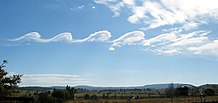Lee wave
The lee waves [ ˈleːˌvɛlən ], which always appear in groups, are gravity waves in the air flow on the side of mountains facing away from the wind ( lee side ) . They often occur in conjunction with a vortex of air known as a leeward, rotor, or whirling roller.
Identifying features
Both the lee waves and the rotor, whose vortex axis is horizontal, are often accompanied by characteristic fixed cloud formations :
- Lens-shaped lenticularis (also called " foehn fish" ) at the vertex of the wave
- cumulus in the ascending part of the rotor (less often)
Dust clouds on the windward side of the mountain can often be observed, but in contrast to the two aforementioned cloud forms, there is no reliable indication of lee waves.
Significance for aviation
The parts of the wave that represent updrafts are a way for gliders to gain height. For other aircraft such as balloons , hang gliders and paragliders, lee waves are more of a danger. The rotors of the lee waves in particular represent severe turbulence and are therefore also dangerous for commercial aircraft , see BOAC flight 911 .
When an aircraft is flying through lee waves (in particular in the area of the lee roller ), the occupants can perceive lee waves as air holes .
Areas of origin
Lee waves typically arise in areas where strong winds often occur across mountain ranges, such as. B. in North and especially South America ( Andes ). For this reason, special test and measurement flights have already been carried out successfully in Argentina.
See also
literature
- A. Dörnbrack, R. Heise, J. Küttner: shafts and rotors . In: promet . tape 32 (1-2) , 2006, pp. 18–24 ( pa.op.dlr.de [PDF; 540 kB ]).
Individual evidence
Web links
- http://www.mountain-wave-project.de/ Research into lee wave rotor systems to increase flight safety
- http://www.schwerewelle.de/ Research into lee waves in the north German low mountain range
- http://www.inglaner.com/meteorologia_onda.htm Chronological collection of meteorological data, satellite images and recordings of the lee waves in Bariloche, Argentina. In Spanish



